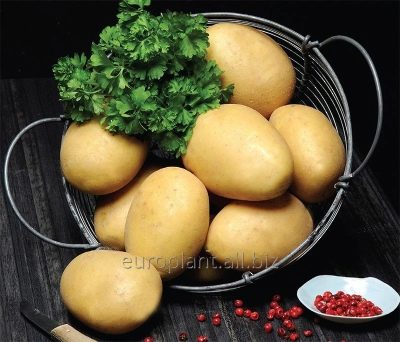
- Authors: BOHM HEINRICH (EUROPLANT PFLANZENZUCHT GMBH) Germany
- Name synonyms: Bernina
- Year of approval: 2017
- Appointment: dining room
- Tuber weight, g: 112-142
- Peel color: yellow
- Color of the pulp: dark yellow
- Starch content,%: 12,1-15,2%
- Tuber shape: elongated oval
- Peel structure: smooth
Many gardeners and gardeners mistakenly believe that potatoes are all the same and unpretentious to care for. However, it is not. There are a huge variety of varieties, and each of them requires certain care, growing conditions. But still there are varieties that can grow in almost all conditions, while not requiring special care. These include Bernina's potatoes, created by German breeders.
Description of the variety
Bernina is a medium-sized table variety. The bushes are medium-sized, spreading, the color of the leaves is light green. The culture is high-yielding. The average weight of one tuber is approximately 112-142 g.
Characteristics of the appearance of the bush and root crops
The potato bushes are tall and lush. The leaves are green with purple blotches, dull, small in size. By the end of the season, the tops lie down.
The inflorescence is multi-flowered. The flowers are purple, red-purple, sometimes double. Form a fruit - a berry.
Tubers are oval, oblong. The skin color is red with dark red eyes. The pulp is light yellow or white. It does not darken on the cut of mature tubers.
Purpose and taste of tubers
Potatoes are suitable for various heat treatment methods: boiling, baking, frying. It does not boil much. If there is a lot of starch in the tubers, it may crack. It gets slightly darker during processing.
Maturation
The variety is mid-season. Ripens within 90 days.
Yield
The yield is consistently high: an average of 221 to 449 centners per hectare. The maximum yield is 704 centners per hectare.
Growing regions
The variety is ideal for growing in the West Siberian region. In the northern part, it is used as an early one due to the rapid ripening of tubers.
Growing and care
Planting methods:
traditional (using a shovel);
non-standard (landing under a film or other covering material).
The variety can be grown not only outdoors, but also in barrels and other containers.
Prepare the soil before planting. The process begins in the fall. The soil is dug up, fertilized with mineral or organic substances. In the spring, it is not necessary to dig up specially, but if the earth is too dense, you can loosen it with a rake.
In the fall, it is necessary to choose planting material from the entire crop. For this, medium-sized tubers without cracks and deformations are suitable. If larger ones are selected, then before planting they need to be cut in half. And also the selected potatoes should be planted. This promotes faster germination and protection against fungal diseases. Prepared tubers are stored in a dark place.
The timing of planting Bernina potatoes varies from region to region. This is due to different climatic conditions. To find the best planting time, it is recommended to measure the temperature in the depths of the soil. The optimal result is from +8 degrees. On average, they are planted in May until early June, when the frost has ended.
When planting in a dug hole, you need to add fertilizer to improve growth.
The Bernina variety does not need special care. Everything is the same as for other types of potatoes.
If necessary, the soil must be loosened. The first hilling is carried out when the height of the bushes reaches 20 cm.Do not sprinkle them too much with earth. The last time they spud after the flowers have fallen off.
Frequent watering is not necessary. The variety is drought-resistant. With excessive watering, the tubers rot.
It is important to remove weeds from potato plantings. Otherwise, they will interfere with growth. The cut weeds can be left in the aisles and used as fertilizer for the next planting.

Planting potatoes is one of the main spring activities traditional for Russian gardeners. There are many ways to plant this vegetable, allowing you to get a good harvest in different conditions and climates. Before planting, you need to carefully prepare the planting material, correctly determine the timing, competently prepare the soil.


Soil requirements
Loamy soils are suitable for growing Bernina potatoes. The highest yield will be where grain and legumes were grown before.

Disease and pest resistance
The variety is resistant to diseases such as:
cancer;
nematode;
mosaic;
rolling leaves.
However, it is highly susceptible to late blight and ring rot. To combat them, in addition to specialized drugs, folk remedies are used. For example, wood ash, infusion of garlic and potassium permanganate.
Disease prevention - timely fertilization.
Colorado potato beetle is a dangerous pest. To combat it, special chemicals are used. It is also important to collect insect larvae.
Despite its relative novelty, Bernina's potatoes have already received numerous positive reviews from those who grew them. If you follow the recommendations for caring for it, a rich harvest will be obtained.

Potatoes are a popular vegetable crop that many gardeners planted on their site. But growing a bountiful harvest of tasty and large tubers is unlikely to succeed if the beds are not properly protected from the most common diseases and pests. Often, the development of diseases of various etiologies of potatoes goes unnoticed, so it is important to identify the problem in time and eliminate it.
















































































